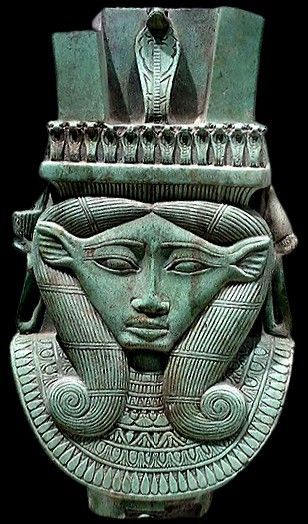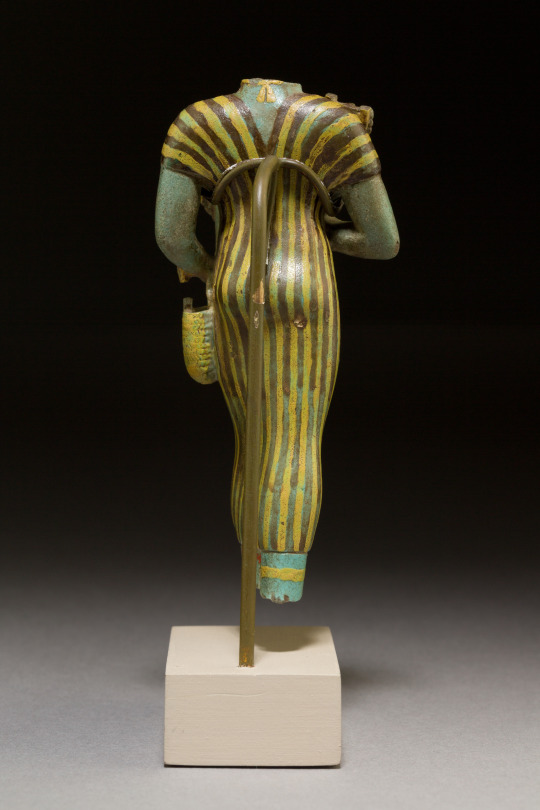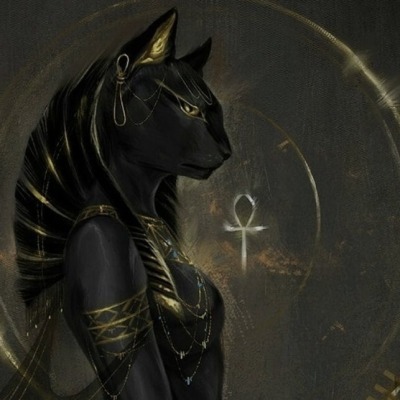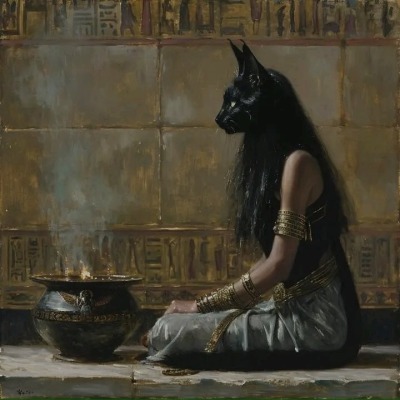#sistrum
Explore tagged Tumblr posts
Text

~ Vignette from funerary papyrus (Book of the Dead) from papyrus N 3149.
Period: Ptolemaic Period
Medium: Papyrus
#ancient#ancient art#history#museum#archeology#ancient egypt#ancient history#archaeology#egyptian#egyptology#egypt#book of the dead#funerary art#funerary papyrus#papyrus#sistrum#hieratic#crown#atum#vignette#Ptolemaic Period
767 notes
·
View notes
Text

Ancient Egyptian faience emblem from a sistrum (rattle), depicting the goddess Hathor. Made by an unknown artist during the Late Period (Dynasties 26-29 = 664-332 BCE). Now in the Metropolitan Museum of Art. Photo credit: Metropolitan Museum of Art.
#art#art history#ancient art#Egypt#Ancient Egypt#Egyptian art#Ancient Egyptian art#artifact#artifacts#sistrum#Egyptian religion#Ancient Egyptian religion#Hathor#faience#Late Period#Metropolitan Museum of Art
452 notes
·
View notes
Text


Roman Bronze Sistrum (Ceremonial Rattle), 1st or 2nd Century CE, said to have been found in the River Tiber, Rome, The British Museum, London
This Egyptian-looking rattle was used by a priest or priestess of Isis in Rome. Some Romans thought worshipping this goddess was suspicious, even dangerous. The maker showed his loyalty to Rome by putting Romulus, Remus and the she-wolf on the top. The she-wolf is licking one of the twins with her big tongue.
#romans#roman empire#roman#archaeology#sistrum#early religion#ancient living#ancient sites#ancient cultures#ancient craft#rattle#ritual#Roman society
63 notes
·
View notes
Text

Bat became the emblem on a sistrum, related to Hathor, which appears on the top of her columns of her main temple of Dendera.
315 notes
·
View notes
Text
British team from the University of Manchester has unearthed new sections of Imet, a 2,300-year-old city in Egypt’s Nile Delta. Radar scans revealed tower houses, grain stores, and a temple to Wadjet, alongside artifacts like a Horus stela and a bronze sistrum. Dating to 400–350 BCE, these finds highlight Imet’s role as a key urban and religious center during Egypt’s Late Period. The discoveries offer a glimpse into daily life and spiritual practices in the ancient Nile Delta
#archaeology#ancient Egypt#Nile Delta#Imet#Late Period#tower houses#Wadjet temple#Horus stela#ushabti#sistrum#Egyptian history#archaeological discoveries#Nile Delta archaeology#ancient urban planning#Egyptian artifacts#religious practices#mudbrick architecture#ground-penetrating radar#University of Manchester#Sharqia Governorate#Tell Nabasha#ancient trade networks#Egyptian culture#Late Period Egypt#temple excavations#ancient Egyptian trade#more specific tags
1 note
·
View note
Text


Hit it, Mery!
0 notes
Photo

Sistre
Le sistre (sorte de hochet) est un instrument de musique à percussion utilisé pour la première fois par les Égyptiens de l'Antiquité, couramment utilisé dans les pratiques musicales de la Grèce antique et souvent représenté dans les arts visuels tels que la sculpture et la poterie. Fabriqué en argile, en bois ou en métal, l'instrument servait d'accompagnement rythmique à d'autres instruments, en particulier lors des rites religieux et des festivals. Les objets mobiles placés sur les barres horizontales ou le mouvement libre des barres elles-mêmes contre le cadre produisaient des sons.
Lire la suite...
1 note
·
View note
Photo

Música y danza en el antiguo Egipto
La música y la danza eran muy valoradas en la cultura del antiguo Egipto, pero eran más importantes de lo que generalmente se piensa: eran parte fundamental de la creación y de la comunión con los dioses y, más allá, eran la respuesta humana al regalo de la vida y a todas las experiencias de la condición humana. La egiptóloga Helen Strudwick señala que «la música estaba en todas partes en el Antiguo Egipto: en los banquetes civiles o funerarios, en las procesiones religiosas, en los desfiles militares e incluso en el trabajo del campo» (416). Los egipcios amaban la música e incluían escenas de actuaciones musicales en las pinturas de las tumbas y en las paredes de los templos, pero valoraban igualmente la danza y representaban también su importancia.
Sigue leyendo...
1 note
·
View note
Text
i have this idea that in the 616 world, Marc collects relics of ancient Egyptian origin but not knowing how or what they do, nor actually take precautions incase that still have curses.
As in, magic relics in an MK run is not always explored nor addressed. At least not in a way where Marc actually knows how to research his own relics, nor understand what text is on them. Or what they actually do.
616 Khonshu even barely explains the relic spells, or any concept of spells that require historical knowledge on Egyptian mythology as all he does is lurk in the background or mess with Marc, or not be real.
But MCU Khonshu does and choses not to actively use relics specifically to avoid using any intellectual knowledge on it, instead he prefers to use his (excuse the pun) fists mindlessly.
But his past and experience with his family makes a huge difference in the 616 world as he have greater mystical experience and is a god in the literal sense.
Like for him Ancient Egyptian relics still have remnants of magic and he is more concern about how sloppily 616 Marc have been collecting them without actually knowing what they do, nor do any precautions incase they actually do have magic.
Resulting in disasterous effects like the magic remnants mixing like some cocktail in a mad scientist lab. Which created this giant super curse that accidentally opens a portal to the underworld. And one that MCU Khonshu have to fix since he knows the original language, spells and the deep understanding of Egyptian metaphysics required to reverse that properly and permanently.
The ancient knowledge and training that 616 Marc and Badr never had and one Marc just refuses to research on.
I doubt Marc even knows how to use a sistrum in ceremonies. Which is traditionally weld by the priest/priestess and believed to use magic that can alter reality.
This rattle wand thing that is closer to the bell wand/Kagura suru that shrine maidens use

1 note
·
View note
Text

2 notes
·
View notes
Text
Have come home for Christmas to my parents and I'm excited to start doing the work I cant do at my flat. I'm gonna rework the academic/creative success spell I did over the summer to help with my end of year portfolio submission + doing divination with planetary powers with some stuff I adapted from @windvexer. Love talking to space rock about life woes.
4 notes
·
View notes
Text







Bastet with Nefertum figure, sistrum, and basket - Met Museum Collection
Inventory Number: 17.194.2214 Third Intermediate Period–Late Period, 945–600 BC Location Information: Location Unlisted
Description:
Although the head, made separately, is now missing, this goddess is identifiable as Bastet. The striped robe is characteristic of the goddess, as are the sistrum and basket she holds. The small statuette with a lotus crown represents her son Nefertum.
#Bastet with Nefertum figure sistrum and basket#bastet#third intermediate#late period#met museum#17.194.2214#location unlisted#womens clothing#TIWC#LPWC#deities#deitiesw
9 notes
·
View notes
Note
I'm getting into darbuka. Do you have a favorite Egyptian percussion instrument?
The sistrum!

19 notes
·
View notes
Text

Naos sistrum made of Faience with Hathor’s Face
367 notes
·
View notes
Text
BASTET



WHO IS SHE?
Bastet, also called Bast, Ubasti, and Bubastis, is a goddess often represented as a lioness or a cat. She was a protective goddess associated with home, domesticity, women’s secrets, cats, fertility, childbirth, marriage, music, magic, sex, prosperity, joy, dance, healing, and pleasure. She is often invoked for protection against evil and misfortune. Bastet was also known as a goddess of joy, music, dance, and perfume, and is often depicted holding or playing musical instruments, such as the sistrum and the lute. She is also closely associated with the goddesses Sekhmet and Mut, which both of whom are depicted as lionesses.
BASIC INFO:
Appearance: Bastet is often depicted as a woman with the head of a cat or a lioness, sometimes holding a sistrum or a basket of perfumes. Her body is typically portrayed as being covered in spots, like a leopard. She is often depicted wearing a wig adorned with a vulture headdress and a necklace with a golden pendant. In some depictions, she is also shown riding in a chariot pulled by lions, and in others, she was shown as a mother nursing her kittens.
Personality: she is known as a kind and gentle goddess who was particularly devoted to her followers and their well-being. She was seen as a protective deity who watched over homes and families, and was often invoked to protect against evil and misfortune. She was also known as a goddess of joyous celebration and music, and was often invoked to bring happiness and prosperity to her devotees. She was often depicted as a protector of women and children, and was known to be a motherly and nurturing goddess.
Symbols: basket, Ankh, the Sun and Moon, perfume jar, sistrum ointment, solar disk, cats, and lions
Goddess of: home, domesticity, women’s secrets, cats, fertility, childbirth, marriage, music, magic, sex, prosperity, joy, dance, healing, and pleasure
Culture: Egyptian
Plants: catnip, vervain, cannabis, lotus flower, cinnamon, mint, and sandalwood
Crystals: cats eye aquamarine, jasper, graphite, xenotime, black tourmaline, pyrite, lapis lazuli, sunstone, moonstone, mangano calcite, tiger’s eye, morganite, and shungite
Animals: cats, lions, cheetahs, leopards, and other felines
Incense: kyphi, rose, cinnamon, mint, and sandalwood
Practices: home protection, feline magick, fertility, sex magick, healing, love magick, personal growth, dance magick, pregnancy rituals, and music magick
Colours: malachite green, black, red, bronze, pink, turquoise, and gold
Numbers: 7 and 9
Zodiacs: Leo and Cancer
Tarot: The Chariot, Strength, and The Sun
Planets: Sun and Moon
Days: Sunday, Monday, Bubastis, and Mabon
Parents: Ra and Isis
Siblings: Horus and Anhur (half brothers)
Partner: Ptah
Children: Maahes
MISC:
Cats: they were believed to be the embodiment of the goddess Bastet, and as such, were considered to be holy creatures. Cats were also seen as symbols of grace, elegance, and fertility, all of which were qualities associated with Bastet. Additionally, cats were also seen as protectors of homes and families, which was one of Bastet's main roles as a protective deity.
Sun and moon: Bastet was sometimes associated with the sun and the moon because she was believed to have a connection to the heavens and the celestial bodies. She was considered a protector of the sun, and was believed to accompany Ra, the god of the sun, on his journey across the sky each day. She was also closely associated with the goddess Isis, who was often depicted holding a sistrum or a lunar disc, symbolizing the moon. Additionally, she was also sometimes depicted as the protector of the nighttime, and was thought to be responsible for bringing light into the darkness.
Ankh: the ankh, which is a hieroglyphic symbol that represents life, was often depicted in association with the goddess Bastet because she was considered a protector of life and fertility. The ankh was believed to have powers that could bestow life and fertility upon those who wore it or had it in their possession. It was also said to protect the wearer from death and evil. As a deity associated with these qualities, Bastet was often depicted with the ankh as a symbol of her protective powers and association with life and fertility.
Basket: she is often depicted holding a basket, which is believed to represent her role as a protective deity. The basket was used to carry items that were believed to have protective properties, such as sacred oils or other sacred items. The basket was also seen as a receptacle for offerings and gifts to the goddess, and was believed to represent the abundance and prosperity that she brought to her followers. In some depictions, the basket is also shown as overflowing with grain, representing her association with fertility and plenty.
Cannabis: in some interpretations, cannabis is seen as having a connection to the goddess Bastet because of its association with female fertility and goddess worship. Cannabis has been associated with many goddesses throughout history, as it was believed to be a sacred plant with spiritual and medicinal properties. Some believe that Bastet was associated with cannabis as a symbol of her protection and power over fertility and abundance, and as a means of connecting with the divine feminine. Other interpretations suggest that cannabis may have been used in ancient rituals and ceremonies dedicated to Bastet as a means of enhancing spiritual connection and achieving altered states of consciousness.
Perfume jar: Bastet was often depicted holding a perfume jar or a container of perfumed oil, which is believed to represent her association with perfumes and fragrances. The scent of fragrances was believed to have powerful properties that could purify the air and drive away evil spirits. The perfumes associated with Bastet were often said to have a floral, musky, or sweet scent, and were believed to have regenerative and protective properties. In addition to their protective qualities, perfumes were also seen as symbols of luxury and wealth, which may explain why they were often associated with the goddess Bastet.
FACTS ABOUT BASTET:
Bastet was worshiped in Bubastis in the Nile River delta and Memphis. Large cemeteries of mummified cats and bronze statuettes of Bastet were created at these sites.
Her name was originally B'sst, which later became Ubaste, then Bast, and finally Bastet. The meaning of her name is not known for certain, but some claim it means "She of the Ointment Jar".
According to Egyptian mythology, the circumstances of Bastet's death are a mystery, but many scholars believe she died while protecting her family.
Many Egyptians saw her feline attributes as all-powerful, with the ability to protect their homes from evil spirits and disease, much in the way cats could ward off vermin.
She works as a psychopomp, a person who leads the deceased to the next life.
Bastet, who was in charge of looking after the dead and the spirit world, was also in charge of destroying the bodies of the deceased who managed to escape from Ma’at’s judgment chamber. In addition, she directed the spirits to the afterlife World. She cared for the deceased and prevented them from fleeing their punishment.
Anyone who damages, kills, or is cruel to cats will suffer the wrath of Bastet and her devotees. Egyptians were so devoted to Bastet and their pet cats that when one died, the cats were also mummified and joined Bastet in The After World.
HOW TO INVOKE BASTET:
Light a candle and place it in front of an image or statue of Bastet, offerings of fresh flowers, especially lotus and roses, and which are associated with Bastet, burn incense, such as kyphi, rose, cinnamon, mint, or sandalwood, which are believed to be scents that Bastet enjoys, speak prayers or affirmations to Bastet, asking for her guidance and protection, and create a small shrine or altar dedicated to Bastet, with items that symbolize her qualities of protection and fertility.
PRAYER FOR BASTET:
Mother of the Gods, the One, the Only,
Mistress of the Crowns, You rule all.
Bastet, Beloved, when Your people call
Daughter of the Sun, with flame and fury,
Flashing from the prow upon the foe;
Safely sails the boat with Your protection
Passing scatheless where Your fires glow.
Daughter of the Sun, the burial chamber
Lies in the darkness ‘til Your light appears.
From Your Throne of Silence send us comfort,
Bastet, beloved, banish all our fears.
Mother of the Gods,
No gods existed ‘til You came there and gave them life.
Trampling down all evil and all strife.
Mother of the Gods, the Great, the Loved One,
Winged and Mighty, unto You we call,
Naming You the Comforter, the Ruler,
Bastet, beloved, Mother of us all.
SIGNS THAT BASTET IS CALLING YOU:
The presence of cats, seeing them in pictures, on television, being followed by cats, and even hearing meowing can be signs.
Seeing images or visions of her in your dreams or while meditating.
Feeling a sense of protection or comfort in her presence.
You experience a sudden or unusual interest in ancient Egyptian mythology or spirituality.
Feeling a sense of joy or celebration when thinking about or engaging in activities associated with her.
A strong connection to the themes of protection, fertility, and abundance in your life, or experience a sudden increase in energy or creativity. It's important to pay attention to your own intuition and feelings when interpreting these signs and signals.
Finding small items associated with the goddess in unexpected places or experiencing a sense of connection to the moon or the night.
Feeling a sudden or unusual attraction to the colour gold.
Experiencing a sudden or unusual interest in perfume or scents.
You begin to experience an increase in your creativity and artistic abilities.
A sudden or unusual urge to protect or care for others.
You experience a sudden or unusual attraction to the arts, music, or other forms of self-expression.
OFFERINGS:
Perfume.
Salves and body scrubs.
Jewelry and other shiny precious to semi precious objects.
Gold items.
Food and drinks: chocolate, sugar water, pastries, beer, garlic, onions, meat (especially chicken and fish), honey, soda, milk, bread, tea, water, fruit/fruit juices, red wine, grains, and lettuce.
Catnip and cannabis.
Lotus flower.
Baskets.
Crystals: cats eye aquamarine, jasper, graphite, xenotime, black tourmaline, pyrite, lapis lazuli, sunstone, moonstone, mangano calcite, tiger’s eye, morganite, and shungite.
Wind chimes.
Cat hair, claws, teeth, whiskers (please don’t cut a kitty’s precious whiskers, wait for them to shed naturally - look for them mostly during summer and on the places your cats spend most of their time).
Music.
Bird feathers (especially peacock).
Instruments, songs, music players, cds, and anything relating to music.
Dance related objects and imagery.
Incense: myrrh, jasmine, lavender, cannabis, and frankincense.
Sun catchers.
Bells.
Herbs: lemon balm, catnip, rose, jasmine, honeysuckle, and mint.
Lunar/sun images and items.
Art you’ve made of her.
Poems and literature.
DEVOTIONAL ACTS:
Love and respect cats, spend some quality time with them.
Protect your loved ones.
Stand up for what is right.
Explore your sexuality.
Do what you love, and love what you do.
Spend some time with your family, whether it be biological or chosen.
Include cats and cat effigies in your practice.
Use a cauldron to burn herbs as incense.
Learn more about Her, and her history.
Cleaning your house.
Donate to, volunteer at, or otherwise support cats at shelters.
Pray to her or write poems in her honour.
Research her.
Honour your mother or the mother figure(s) in your life.
Protect and fight for the innocent.
Dance!
Play music or create a playlist in honour of her
Learn about perfume and scented oils and how they were used and made in Ancient Egypt.
Take care of your home.
#fyp#fypシ#fypシ゚viral#fypage#fyppage#tumblr fyp#witchcraft#witch#witches#deity#deity work#bastet#egyptian deities#egyptian goddess#ancient egypt#information#helpful#masterlist#themortuarywitch
200 notes
·
View notes
Text
me: i need a sistrum…
my brain: no you fucking don’t, close etsy right the fuck now
me, browsing etsy: i need a pair of ankh earrings
my brain: okay a.) you already have a pair and b.) you have another pair that are pretty much permanently affixed in your third lobe piercings?? are dumb bitch hours now??
me: yeag :)
#i actually have been wanting a sistrum for a long time#and there’s a sekhmet one in my favorites#but ok FINE
2 notes
·
View notes